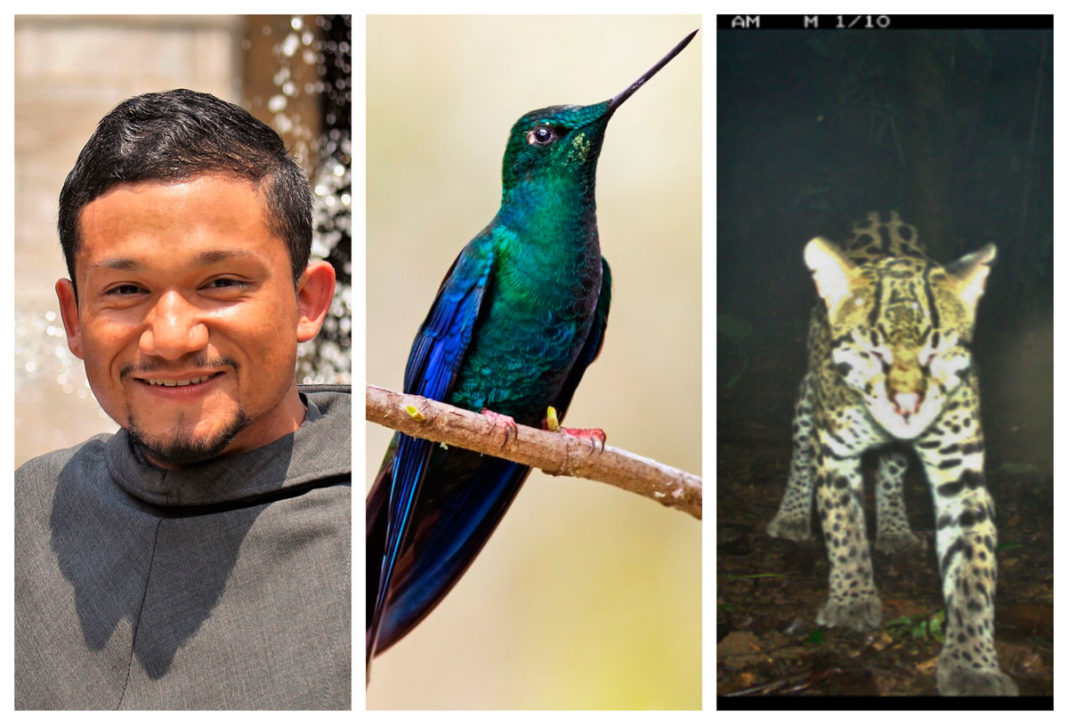A young friar who was doing field research a few years ago is revisiting his work during formation. His former ecological research is finally completed and published in scientific journals.
 Friar Christopher FERNÁNDEZ is completing his first year of post-novitiate studies at the Catholic University of America in Washington, D.C. He is a student-friar of the Province of Our Lady of the Angels in the USA. He is also “ completing” a couple of old research projects. Recently, his hummingbird species life history project, from his days of undergraduate research, was published through the Cornell Lab of Ornithology (Ithaca, New York, USA). This caught the attention of many friars who have a special affection for these little creatures. Little did these friars realize that this particular species, Pterophanes cyanopterus, (whose common name in English is the Great Sapphirewing Hummingbird) is a huge, spectacular hummingbird, larger than almost all other hummingbirds. Native to the montane forests of the Andes, ranging from northern Colombia to Bolivia, these birds have a slower wingbeat compared with the typical hummingbird wingbeat.
Friar Christopher FERNÁNDEZ is completing his first year of post-novitiate studies at the Catholic University of America in Washington, D.C. He is a student-friar of the Province of Our Lady of the Angels in the USA. He is also “ completing” a couple of old research projects. Recently, his hummingbird species life history project, from his days of undergraduate research, was published through the Cornell Lab of Ornithology (Ithaca, New York, USA). This caught the attention of many friars who have a special affection for these little creatures. Little did these friars realize that this particular species, Pterophanes cyanopterus, (whose common name in English is the Great Sapphirewing Hummingbird) is a huge, spectacular hummingbird, larger than almost all other hummingbirds. Native to the montane forests of the Andes, ranging from northern Colombia to Bolivia, these birds have a slower wingbeat compared with the typical hummingbird wingbeat.

Friar Christopher is a conservation ecologist by training, a field in which he has been involved since he was in primary school. His work in professional environmental conservation started in earnest during high school, when he became a volunteer intern at the Smithsonian National Zoo. His early interactions with the Smithsonian influenced his decision to pursue tropical ecology while completing his undergraduate degree. Over two summers, Friar Christopher studied and worked in the rainforests of Costa Rica—focusing his work for the most part on forest fragmentation in the lowland Atlantic rainforest. The field component for this research project was completed in 2016. However, his final paper was also recently published, in 2019, early on during his novitiate year. The article can be found in the scientific journal Tropical Ecology. In addition to these projects, Friar Christopher has co-authored three other pieces of research related to ecological conservation.

Currently, he is in residence at the St. Bonaventure friary and house of studies in Silver Spring, Maryland, USA. He is a religious brother working towards a master’ s degree in Theology, Religion, and Culture Studies—a program which gives him the flexibility to fulfill his formation requirements while also exploring Franciscan studies, eco-theology, and social issues. Friar Christopher is interested in advancing his knowledge of conservation ecology and issues in the human dimensions of environment—rooted in integral ecology and Catholic social teaching, according to the guidelines set forth in the encyclical Laudato Si’. He is excited about advancing conversations in religious involvement in community-based conservation, environmental conflict mitigation, and addressing the nexus between poverty, environment, and religion. His scientific publications are as follows:
-Fernández, C. M., D. Luther, I. Heynen, P. F. D. Boesman, and G. M. Kirwan (2021). Great Sapphirewing (Pterophanes cyanopterus), version 2.0. in Birds of the World (T. S. Schulenberg and B. K. Keeney, Editors). Cornell Lab of Ornithology, Ithaca, NY, USA. https://doi.org/10.2173/bow.gresap1.02
-Fernández, C.M., Vera Alvarez, M.D. & Cove, M.V. Heightened nest loss in tropical forest fragments despite higher predator load in core forest. Trop Ecol 60, 281–287 (2019).
-Cove, M.V., Fernández, C.M., Alvarez, M.V., Bird, S, Jones, D.W., & Fagan, M.E. (2017) Toucans descend to the forest floor to consume the eggs of ground-nesting birds. Natural History Note in Food Webs, 10, 2-4.
-Luther, D., Skelton, J., Fernández, C., & Walters, J. (2016). Conservation action implementation, funding, and population trends of birds listed on the Endangered Species Act. Biological Conservation, 197, 229-234.
Friar Christopher FERNÁNDEZ














